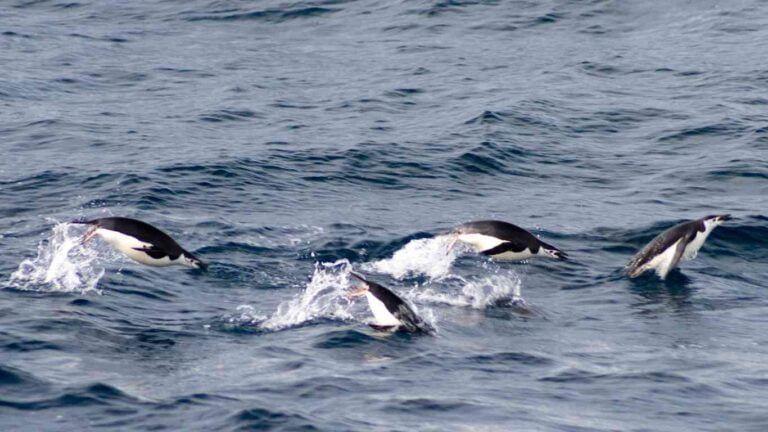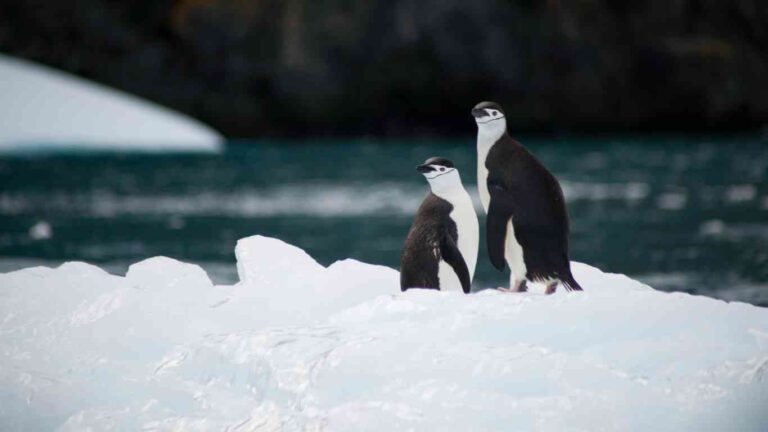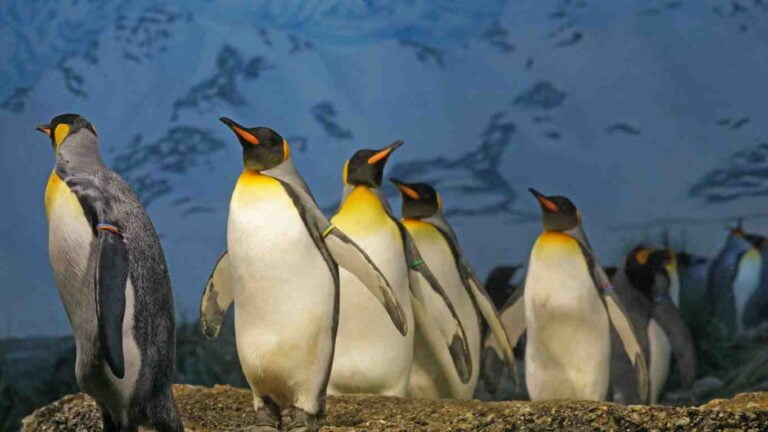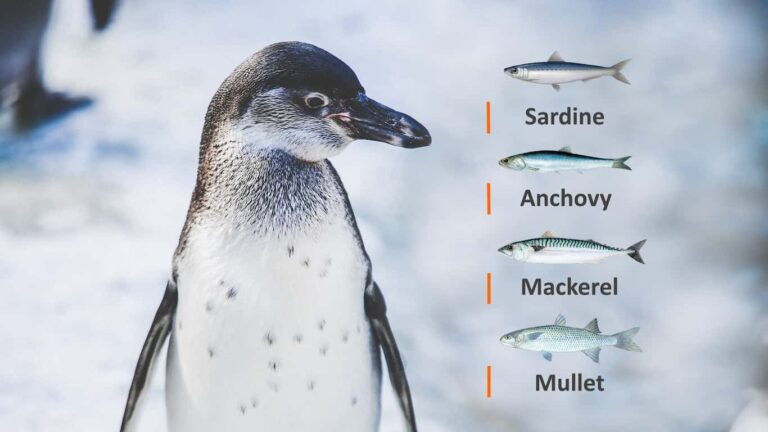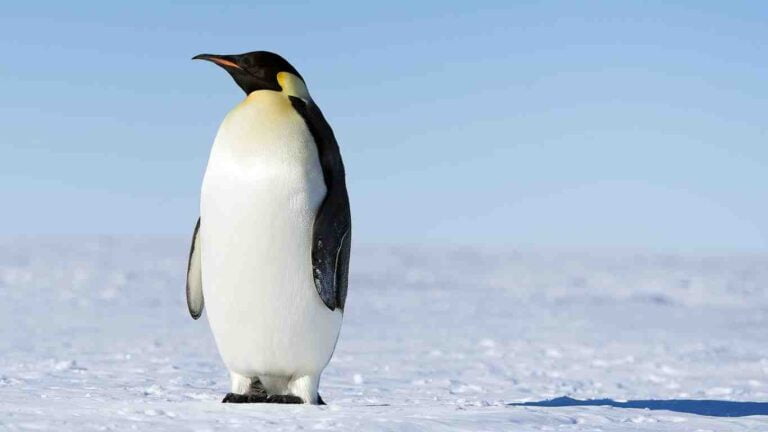30 Emperor Penguin Fun Facts That Will Blow Your Mind!
Emperor Penguins are the towering giants of the penguin world and hold a certain regality that is both endearing and impressive.
Their exceptional adaptations and captivating social behaviors have ignited widespread fascination.
Explore the fascinating world of Emperor penguins, focusing on their distinctive behaviors and remarkable adaptations to chilly environments.
30 Emperor Penguin Interesting Fun Facts
Emperor penguins, with their striking black and white plumage, stand out as a fascinating and iconic species of the Antarctic region.
Here are 30 interesting, cool and fun facts about Emperor Penguins:
1. Emperor Penguins are the Largest Penguin Species
Emperor Penguins stand at a mighty height of up to 1.2 meters (4 feet) and can weigh as much as 40 kilograms (88 pounds).
2. Emperor Penguins’ Layers of Feathers Protect Them from Cold and Water
Emperor penguins have several layers of scale-like feathers that protect them from icy winds and provide waterproofing for their frequent dives.
3. Emperor Penguins are Exceptional Divers
Emperor penguins are phenomenal divers and can reach depths of over 500 meters (1,640 feet), holding their breath for around 20 minutes.
4. Emperor Penguins Migrate Long Distances for Breeding
Every year, Emperor Penguins migrate miles to their breeding grounds, walking in a distinctive waddle or sliding on their bellies. They can travel up to 75 miles over the ice to reach their breeding grounds.
5. They are Sociable, Colonizing Animals for Survival and Warmth
They are known for their sociable nature, forming large colonies for warmth and increased chances of survival.
6. Emperor Penguins Identify Mates and Chicks Through Distinct Calls
With thousands in a colony, Emperor Penguins can identify their mates and chicks through distinct calls among a cacophony of squawking.
7. Extreme Winter Temperatures Mark Start of Breeding Season
Breeding season starts in the dead of winter, with temperatures plummeting as low as -60°C (-76°F).
8. Male Penguins are Devoted Fathers, Selfless Protectors
Males penguins incubate the single egg laid by the female on their feet under a flap of skin, and they don’t eat during this period, surviving on their body reserves.
9. Emperor Penguin Chicks Depend on Parental Warmth and Grow Fast
After hatching, chicks stay on their parents’ feet for warmth. If a chick falls off, it can freeze to death within minutes. Despite being born in the coldest environment on Earth, Emperor Penguin chicks grow rapidly, shedding their fluffy down for waterproof juvenile feathers within a few months.
10. Their Striking Curved Bill Designed for Catching Fish
Their bill is strong and curved downwards to assist in catching fish, their primary food source.
11. Emperor Penguins Dive Deep for Fish, Squid, and Krill
Emperor penguins’ diet consists mainly of fish, squid, and krill; emperor penguins catch their prey by diving deep into the ocean.
12. They Have Efficient Circulatory System for Heat Conservation
These birds boast a specialized circulatory system adapted to conserve heat, with a counter-current heat exchanger ensuring minimum heat loss.
13. Emperor Penguins Huddle for Warmth in Antarctic Cold
To combat the harsh Antarctic cold, Emperor Penguins form tightly packed huddles; moving as a collective group to share warmth and rotate exposure to the elements.
14. Penguin Parents Often Adopt Orphaned Chicks in Colonies
If a chick is orphaned, it is common for other penguin parents within the colony to adopt and care for it.
15. Emperor Penguins Use Bellies for Swift Steering While Traveling
When they need to travel swiftly, Emperor Penguins are known to propel themselves on their bellies, using their flippers and feet for steering.
16. They Breed on Ice with Mobile Egg Balancing System
They don’t make nests; instead they breed on the ice, and have a mobile system of balancing the precious eggs on their feet.
17. Emperor Penguins are Graceful Swimmers in Icy Waters
Emperor Penguins are capable swimmers, with speeds averaging 6-9 kph (3.7-5.6 mph), they elegantly navigate the icy waters in search of food.
18. Unique Breeding Cycle of Emperor Penguins in Antarctic Winter
Emperor Penguins have a unique breeding cycle that aligns with the harsh conditions of the Antarctic winter, ensuring their chicks are ready to face the elements when spring arrives.
19. Thick Dead Skin and Claws Help Emperor Penguins on Ice
The bottoms of an Emperor Penguin’s feet are covered with a thick layer of dead skin and powerful claws, which help them to navigate slippery ice and protect them from cold.
20. Emperor Penguins Have Built-In Goggles for Underwater Hunting
The Emperor Penguins’ eyes are adapted to see clearly underwater, helping them hunt for prey in the dim light beneath the ocean’s surface. They have a third eyelid that acts like a pair of goggles. This built-in goggles help protect against the glare of ice and water,
21. Emperor Penguins Depend on Sea Ice for Survival
Their very existence is closely tied to the presence of sea ice, which they use for rest between forages, escape from predators, and, most importantly, for breeding.
22. Emperor Penguins Have Unique Yellow and Orange Markings
While predominantly black and white, which works as camouflage from predators (counter-shading), Emperor Penguins have distinctive yellow and orange markings around their necks and ears, adding a splash of color to their appearance.
23. Problem-Solving Emperor Penguins Work Together to Catch Prey
Emperor Penguins have displayed problem-solving abilities and can work together to solve challenges in their environment, such as locating and capturing agile prey.
24. They Use Low-Frequency Sounds for Communication in Breeding Colonies
They can utilize low-frequency sounds, similar to infrasound, that can travel long distances, ensuring communication over the noisy and chaotic breeding colonies.
25. Aunts and Uncles Help Care for Young Emperor Penguins
Outside of direct parental care, “aunties” or “uncles” may assist in looking after young penguins, showcasing communitarian behavior for survival in extreme conditions.
26. Emperors Adapt to Cold with Unique Huddling Behavior
Emperors have a layer of dense feathers, a fat layer, and a unique huddling behavior that helps regulate body temperature in extreme cold.
27. Emperor Penguins Are Serially Monogamous During Breeding Season
Each breeding season Emperor Penguins are serially monogamous, taking one partner throughout the season to produce and raise chicks.
28. Emperor Penguins Endure Brutal Winter to Incubate Eggs
Male Emperor Penguins will survive without food and endure the brutal winter while incubating the egg for around two months.
29. Emperor Penguins Near Threatened Due to Climate Change
Emperor Penguins are currently considered near threatened, with their environment being drastically affected by climate change. They rely on sea ice for breeding and feeding, and the unpredictable changes can impact their survival.
30. Emperor Penguins’ Life Cycle Portrayed in “March of the Penguins”
The life of Emperor Penguins was famously documented in the film “March of the Penguins,” which brought public attention to their life cycle.
(Featured image by Christopher Michel)



